Choosing equipment for backpack hunting is difficult. Hunting is a gear-intensive activity, but carrying all of that gear into the mountains can be way too strenuous, so it is important to assess the weight of every piece of gear you carry.
Hunting optics are one of the heavier categories of hunting equipment. I have tried to keep my optics as light weight as possible, while still maintaining the ability to see long distances. I have recently begun using a lightweight spotting scope. (the Kowa TSN 554 reviewed here) in conjunction with a pair of 8×32 binoculars. This combination saves weight over full size binoculars and spotting scope, but still allows me to pick out animals several miles away.
However, using a spotting scope effectively requires a tripod. Without a tripod, the image is too shaky to see clearly. Unfortunately, even most “lightweight” tripods are pretty heavy, with most of them weighing as much (or more than) my tent.
In an attempt to shave some weight off of my pack, I have been trying out three of the lightest tripod solutions I know of: The Trailpix tripod adapter; the Granite Peak tripod, and the Sirui T-024x. After the fall deer and elk season, and a spring hunt for javelina, here are my thoughts on these systems.
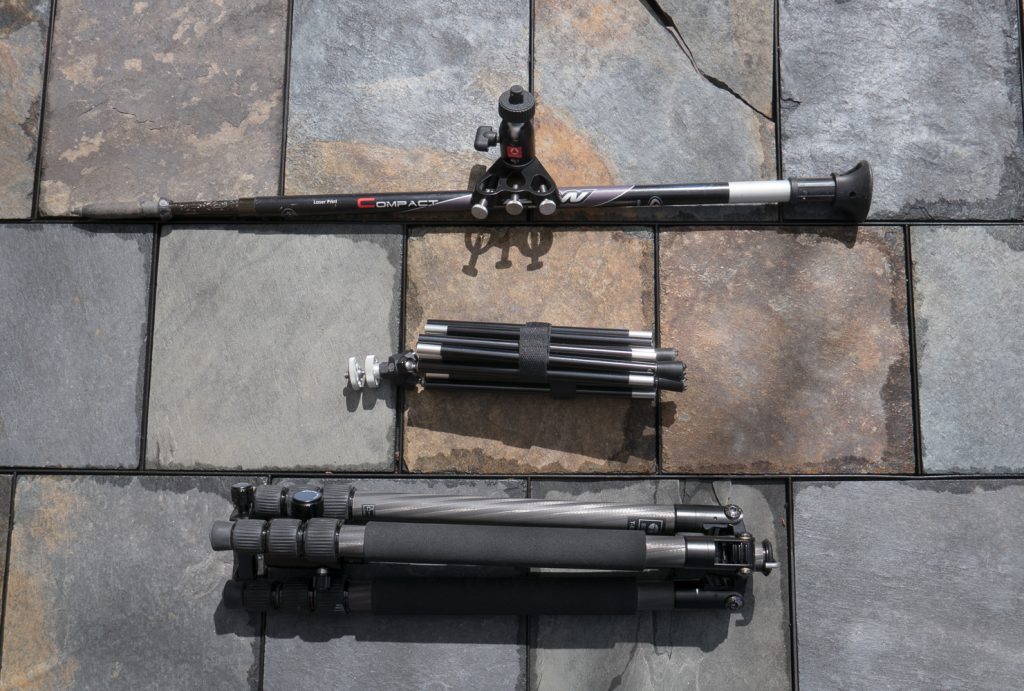
Weights for the three tripods:
Granite Peak Tripod and ball head 9.7 ounces
TrailPix trekking pole tripod adapter with ball head 5.2 ounces
Fizan trekking pole for Trailpix 5 ounces
Sirui T-024X Traveler Light Carbon Fiber Tripod with C-10S Ball Head 33.7 ounces
Hunting Use
When using a tripod for photography, most of the time, I am standing up. However, when using a tripod for mounting a spotting scope for hunting, the majority of the time I am using it while sitting on the ground. So, it’s important that the tripod supports the scope well while relatively low to the ground. Often, I’m using the tripod with my legs under the tripod legs.
When glassing a mountainside, the tripod needs to be able to adjust up and down easily. That is because when you are glassing a steep mountain, you need to be able to raise and lower the tripod so that you can glass with minimal strain on your neck. (Adjust the tripod, not your neck and back.)
It’s also important that the tripod is able to be deployed quickly. Although most of the time, I’m not in a huge hurry, if the tripod takes too long to get set up, then I’m less likely to use it.
Sirui T-024X Traveler Light Carbon Fiber Tripod with C-10S Ball Head
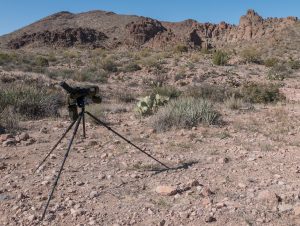
The Sirui is a traditional tripod design, but made from lightweight aluminum and carbon fiber to cut weight. It has 3 section extendable legs, and an extendable center column. It comes with a nicely made ball head that is smooth and secure. My only complaint about the ball head is that the detachable plate secures to the scope with a bolt that doesn’t have a D-ring, so to secure it to the scope, you needed to use a screw driver. I replaced it with an aftermarket D-ring model I bought from Amazon for $4, and it is now much easier to secure by hand.
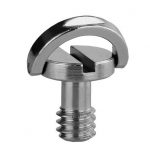
In use, the Sirui tripod was very user friendly. It works well for sitting on the ground or sitting on a log, and is quite easy to deploy. Vertical adjustments are simple, as it has a locking center column that provides lots of vertical adjustment. A quick twist of the center column locking collar, move the column up or down, then a quick twist to re-lock.
This tripod handles larger, heavier spotting scopes too, and easily worked with my full size 88mm spotter with no problems. Overall, this is a versatile and easy to use tripod, and a good choice for folks who want to carry a heavier spotter and/or want the full features of a traditional tripod design.
Trailpix Tripod Adapter
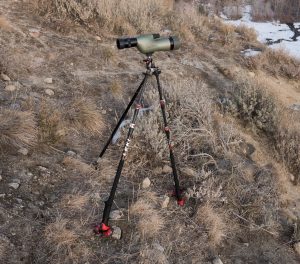
The Trailpix adapter is made to be used with your trekking poles. It’s a plate with a ball head that attaches to the tips of your trekking poles to turn them into a tripod. You just insert your pole tips into the adapter plate, then secure them with some thumb screws. It is surprisingly stable.
One obvious issue is that most people only carry 2 trekking poles, so a 3rd pole is required to complete the system. Trailpix provides a shockcorded aluminum pole for use as the 3rd pole, but I found this to be not very practical, as it was too tall to use comfortably when sitting, and there was not easy way to change the height. Instead, I just carry a third trekking pole. I stripped the handle off of it to reduce weight. (Marmots had already chewed much of the handle off anyway, so I wasn’t too worried about ruining the pole for other uses.)
The Trailpix system is quite clever, and makes use of trekking poles that I already carry with me. In use, it is very sturdy, and had no issues supporting my lightweight spotting scope. The ballhead is decent, and was easy enough to adjust and secure. while not as smooth as the Sirui, it was adequate.
The Trailpix system has a few limitations for hunting. The first is that it takes a bit longer to set up. Inserting your trekking poles into the adapter and adjusting them to the right height takes longer than the other lightweight options reviewed here. The biggest problem, however, is that the Trailpix system is not really designed for use while sitting on the ground. The angle of the poles is fixed and there is no adjustment. This means that when the poles are adjusted very low, the angle isn’t wide enough for maximum stability. You can make it work, but it’s not ideal.
Once set up, vertical adjustment can typically be done by simply adjusting the height of a single pole, which is not too bad.
The genius of the Trailpix system is that it utilizes the trekking poles that you are carrying with you anyway. However, this is also a possible negative, as I also tend to use trekking poles for supporting my tarp, and also use them as shooting sticks for resting my gun on while shooting (when I’m not shooting prone.)
Overall, the Trailpix is a decent system, but if they made a version of the plate with a wider pole angle (for lower to the ground deployment) it would be much better.
Granite Peak Tripod
The Granite Peak Tripod is made in Montana by the folks at Kramer Designs. They are a hunting focused company best known for their lightweight rifle bipod, the Snipepod.
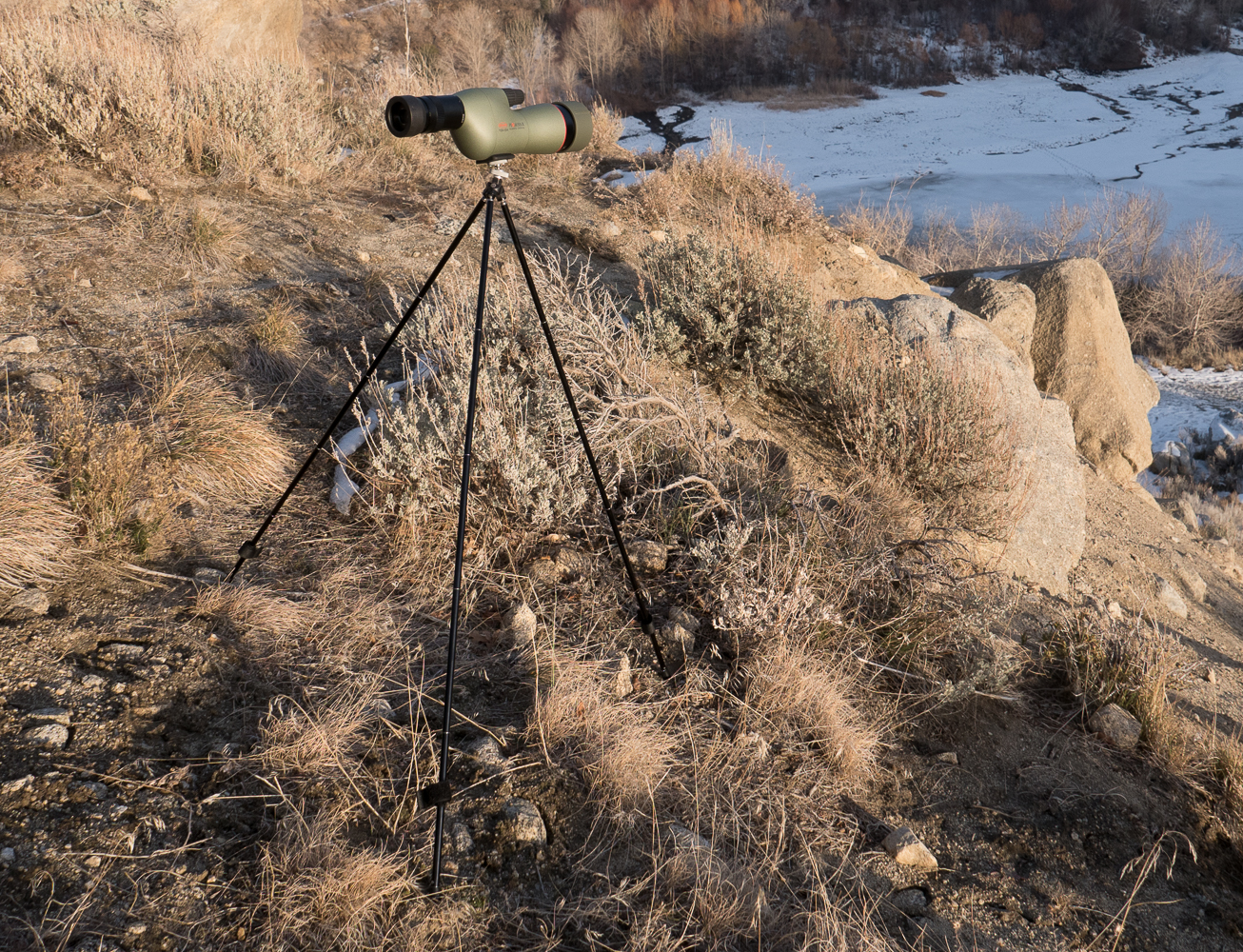
The Granite Peak is a shockcorded aluminum pole system with an ultralight custom made ball head mounted to it. The poles are pretty much similar to aluminum tent poles. The poles attach to the ball head with sockets that are infinitely adjustable in angle, so you can spread the legs in any direction you want, from flat to vertical, front to back. It looks pretty flimsy, but in practice, it supports my lightweight spotting scope adequately. (There is an optional string attachment for suspending a water bottle or other weight in the center of the tripod to add stability, but I haven’t found it to be necessary in most conditions, and it tends to get in the way of my legs when I’m sitting with the tripod legs deployed over me.)
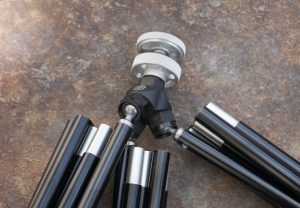
The Granite Peak tripod comes in different sizes. I originally ordered the 33 inch legs, but after some use, went to the 42 inch legs, as I found that when sitting on a steep slope, I wanted the extra leg length for the downhill leg. It’s pretty simple to reduce the leg length, as you can just fold up a couple of the leg segments and then secure them with the velcro tab that is permanently attached to each of the legs.
In use, the Granite Peak works pretty well. The infinitely adjustable legs in their sockets makes the tripod very easy to set up on uneven ground, and also makes it easy to adjust while in use. (Just grab a leg, and push it back or pull it forward to decrease/increase height.) Stability is adequate, but the legs have some flex in them. In windy conditions or at higher magnifications, I have found that a hand on the tripod to steady it is often helpful.
The ball head is an ultralight custom machined item that works adequately. It is a little bit fiddly when compared with a regular ball head, but gets the job done. With most other ball heads, it’s not too hard to find a sweet spot of adjustment that allows you to maneuver the optic while providing just enough friction to prevent the optic from flopping about. The Granite Peak ball head goes from locked to floppy very quickly, and finding the correct friction setting for scanning and panning takes a bit more effort.
Overall, the Granite Peak system is very well thought out, and extremely versatile for varied terrain and body positions, provided you are using a lightweight optic.
Summary
I have summarized my findings in the table below. The scoring for the Stability, Ball head, adjustment and deployment is on a 1-5 scale, with 5 being the top score.
Weights:
Granite Peak Tripod and ball head 9.7 ounces
TrailPix trekking pole tripod adapter with ball head 5.2 ounces
Fizan trekking pole for Trailpix 5 ounces
Sirui T-024X Traveler Light Carbon Fiber Tripod with C-10S Ball Head 33.7 ounces
| Stability | Ball Head Function | Ease of Adjustment | Ease of Deployment | |
| Trailpix | 3.5 | 3.5 | 3 | 2.5 |
| Granite Peak | 2.5 | 2.5 | 5 | 4 |
| Sirui | 4.5 | 4.5 | 4 | 4 |
Conclusion
So, after a long season of use, scouting and hunting, which of these would I recommend? For backpack hunting use with a lightweight spotter, my favorite is the Granite Peak tripod. The ball head is somewhat compromised due to it’s extreme light weight, but it is adequate, and the overall design of the tripod is extremely versatile. I can live with the decreased stability in return for the other advantages. Weight is less than 1/3 of the Sirui, which is one of the lightest traditional tripods on the market.
For day trips, when I’m not carrying much weight, I tend to go with the Sirui, because it can handle my big spotting scope, which I don’t mind carrying if I’ve only got a day pack’s load of gear. If I was going to spend most of my time glassing with my spotting scope instead of my binos, I would opt for the Sirui. However, I tend to glass at least 80% of the time with binos, and only use the spotter for checking out specific locations of interest, so the Granite Peak is adequate for my typical use.
If they came out with a Trailpix with a wider stance (making it more useful for sitting) it would be a contender because of its stability and heavier weight bearing ability, but right now, it’s surpassed by the Granite Peak.
